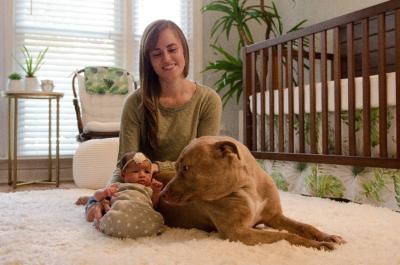Preparing Your Dog for Baby

As parents, there are many stresses that come with bringing home a new baby, but this experience can be equally as stressful for your dog. A new baby will introduce a lot of changes to your dog’s life, not only with sights, sounds, and smells, but also with schedules. And, of course, when the baby grows older, the baby interacting with the dog can provoke routine physical and emotional stress as well. The same way it is important to prepare your house for a new baby, it is important to try to prepare your dog for baby’s arrival too.
Some of the earliest things you can do to help your dog get ready for a baby are to show the dog baby’s furniture, clothes, toys, and gear as they show up and get set up in the new nursery. Allow the dog to spend time in the nursery and adjust to the new surroundings, unless you plan on having the nursery be off limits for the dog when baby arrives.
If your dog has never met a child or baby before, take them to a park (leashed of course!) where they can hear and see children playing or babies crying. Or, if you have family or friends with children that would be comfortable with it, introduce your dog to a baby or child for a short period of time.
If you anticipate any major changes to your dog’s routine when baby arrives (shifts in walk times, walking with a stroller, etc.), try to practice some of these changes before the baby comes. You could even consider practicing with a baby doll. If your dog is not trained, consider formal training classes so the dog can learn basic commands—"sit,” “down,” “stay,” “leave it,” and “go away” are all helpful for the dog to understand and obey before baby’s arrival.
Once the baby is born, allow the dog to get used to baby’s scent by having someone pick up clothing or a hat from the hospital that baby has worn and letting the dog smell it. When baby arrives to the house, try to place baby in their car seat somewhere inaccessible to the dog while the adults greet the dog and the dog settles, then allow for a gentler and more subdued introduction to the baby.
As the baby grows and becomes more interactive, continue to work with the dog and the baby on appropriate interactions. Keep babies/kids away from dogs while they are eating to help prevent bites. Never allow a dog to be in a room with a baby unsupervised, even if the dog and/or baby are sleeping.
If you have any specific questions or concerns about your dog interacting with baby, contact your veterinarian and/or pediatrician for further information.
For more information about bringing home babies to dogs, as well as for dog training tips, see the ASPCA’s website:
https://www.aspca.org/pet-care/dog-care/dogs-and-babies
For bringing a new pet home to existing kids, please see the following article at healthychildren.org:
https://www.healthychildren.org/English/safety-prevention/at-home/Pages/Before-Choosing-a-Pet.aspx
For further information on how to keep infants and young children healthy with various types of pets and other animals (not just dogs!), please see the following article from the CDC:
https://www.cdc.gov/healthypets/specific-groups/high-risk/children.html
